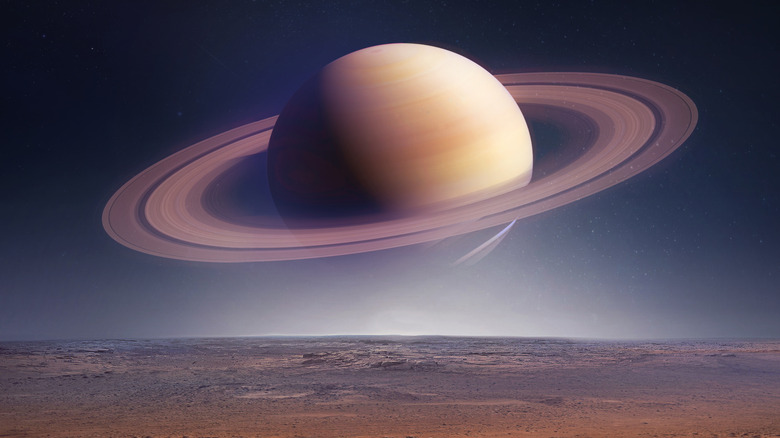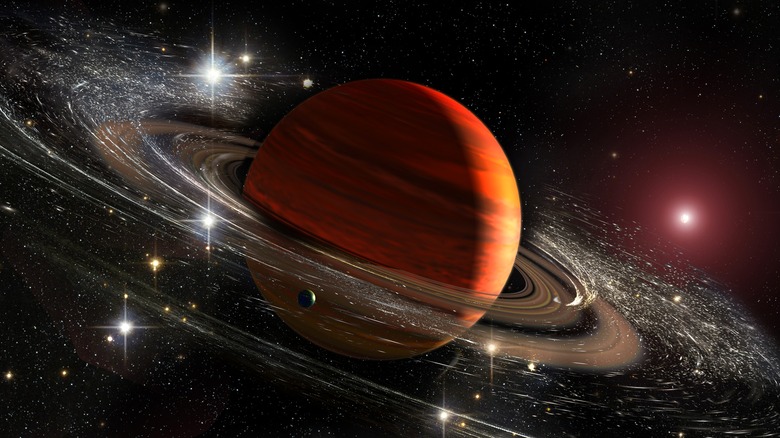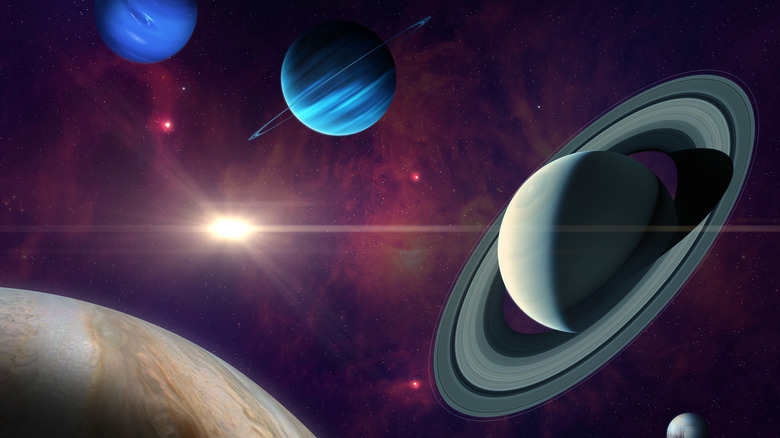This Ancient Moon Could Answer Two Cosmic Mysteries According To Scientists
Scientists have long stared into the sky and wondered aloud about Saturn's unique visual and physical characteristics. Saturn plays host to 83 moons and an intricate series of rings that are not unique in the universe but unseen in such spectacular fashion around any other planet (Big Think notes two small rings around Neptune) in our solar system (via NASA). Similarly, the tilt of the planet is far greater than it appears it should be, given what we know about the physical makeup of planets and other objects beyond the Earth.
These stunning rings and the bizarre, 27-degree tilt of the planet had long stumped researchers who strive to make sense of phenomena existing in the space beyond our natural world. Recently, scientists have formulated and rigorously tested a new theory that explains both of these Saturn questions. Scientists believe that there once was another moon orbiting Saturn that was roughly the same size as Iapetus, making it potentially the third largest moon orbiting the planet (via Science). At one point, around 160 million years ago, this moon became destabilized and eventually was drawn into a collision course with Saturn's surface. Contact between these two celestial bodies, researchers believe, explains both the awkward tilt of Saturn's axis and the establishment of the spectacular rings that dance around the gas giant's swirling, marbled surface.
The rings are formed of finely ground moonrock
Scientists have long hypothesized what might happen if a moon where to suddenly fall out of orbit and crash down to the surface of its planet. Generally speaking, there are two distinct schools of thought in this regard. On one hand, a small celestial body would likely be shredded in the atmosphere of the much larger planet, resulting in tiny particles that would eventually swirl around the planet in and fall into stable orbit, forming rings in the process (via Business Insider). On the other hand, if the moon were large enough, it would make impact with the planet surface and set off what would likely be a chain reaction of seismic activity. Business Insider notes that in the event of this moon collision, both outcomes likely occurred. Data from the Cassini satellite which orbited Saturn for 13 years has been used to explore both of these mysteries, resulting in a finding that another, ancient moon is the culprit.
The researchers named this moon Chrysalis, in poetic fashion. The team noted that the Saturn we see today is a sort of evolved form that would not have been present in the night sky had humans looked up at it almost 200 million years ago. In the same way the caterpillar forms a chrysalis and emerges as a new and unrecognizable being, this moon transformed the surface, orbit, and surrounding environment of Saturn.
Saturn's tilt appears to be a combined effort of lunar impact and disconnect from Neptune
One revelation that has made these discoveries clear is that researchers have found evidence pointing to in change in Saturn's tilt that happened around 160 million years ago, aligning with the disintegration of the moon Chrysalis (via Science). Researchers suggest that this collision was the driver behind the way Saturn interacts with Neptune. Planets interact with one another gravitationally in a phenomenon known as orbital resonance, according to Science Direct. This happens when planets move in and out of sync with one another over the course of their orbit around the Sun (or in the case of planets in another solar system, a different Sun). Researchers believe that falling out of resonance with Neptune is what caused this dramatic tilt to occur. The impact from Chrysalis, although insignificant when considering planetary mass and the monumental gravitational field that is created as a result, appears to have been just enough to ever so slightly alter Saturn's orbital course. This change then pushed Saturn just out of orbital resonance with Neptune, ultimately tilting the planet over on its side.


